"Self-Portrait in St. Petersburg" (2015)
Freehand pencil sketch using 4B and HB pencils. Drawn on a train from Moscow to St. Petersburg, with focus on blocks of unblended shadows and looser, flowing shapes. The goal was to blend realistic and surrealistic styles between face and hair. The linework outlining the profile purposefully thins and thickens to create delicacy.
More from this Category:

"Untitled" (2016)
Drawn with ink and pencil. This sketch was intended to show the artist's style of interconnected shapes with a human face. Curves, sharp angles, and continuous lines dominate this piece. Thicker shapes mark the lips, brows, and eyes. The eyes themselves are intended to unsettle the viewer with their empty gaze. Pencil was used to fill in the lower lip, eyes, and outline the flower in the hair.
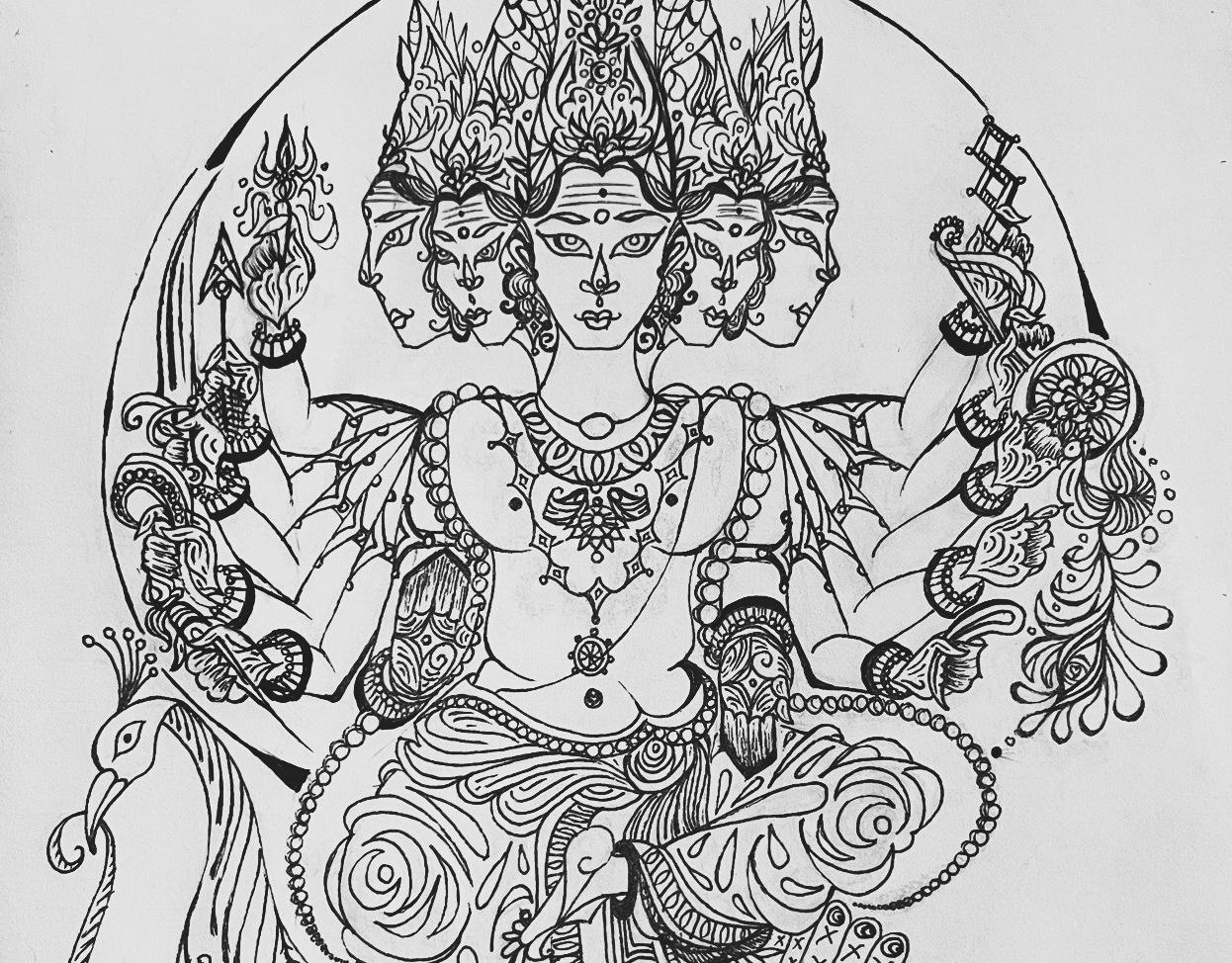
"War God: Karthikeya" (2024)
Drawn with ink. This piece depicts the five-headed, ten-armed form of Karthikeya, the Hindu god of war. His vehicle is a peacock which bites a snake, representing the triumph of good over evil. He carries different weapons in his hands, including: a sword, a trident, an arrow, a bow, a shield, and a noose. In his third arm on the right, he carries a rooster, which is his symbol. Each of his foreheads is marked with the symbol of his father, Shiva, and each of his heads are tilted in a different direction. A halo glow fits around in body in a circle. His chest is adorned with jewelry and his pants are drawn stylistically to show their draping. His first and second hands are facing forward to bless the onlooker. This piece is inspired by Raja Ravi Varma, the Indian painter who often chose mythological figures as his subjects. There is intense detailing in the crown and in the hands, as well as the attention to maintaining general symmetry in the arms and heads. The style of the peacock is inspired by Russian Orthodox icons. Note: the number of heads and arms is symbolic for deities in Hinduism, and the artist wanted to challenge herself with this piece, hence the outcome!

"Umbrella Buddies" (2020)
Drawn with colored pencils and ink. This illustration is of a green songbird and a squirrel clutching an umbrella for them to share under pouring raindrops and snowflakes. All elements of this piece are drawn stylistically, with curved shapes, looped lines, and zig-zagged puddles. A warm color scheme was used for the squirrel and cool tones were used for the songbird. Both are wrapped in similar yellow scarves, and both have tilted, black eyes. The shapes of their bodies are brought out through repetition in linework, and repetition is also seen in the patterns of rain and snow. The umbrella handle tapers down to a few dots, as though it is made of a twig. The mood of the piece is meant to be cheerful, festive, and merry. An ink outline is provided below (scroll down).
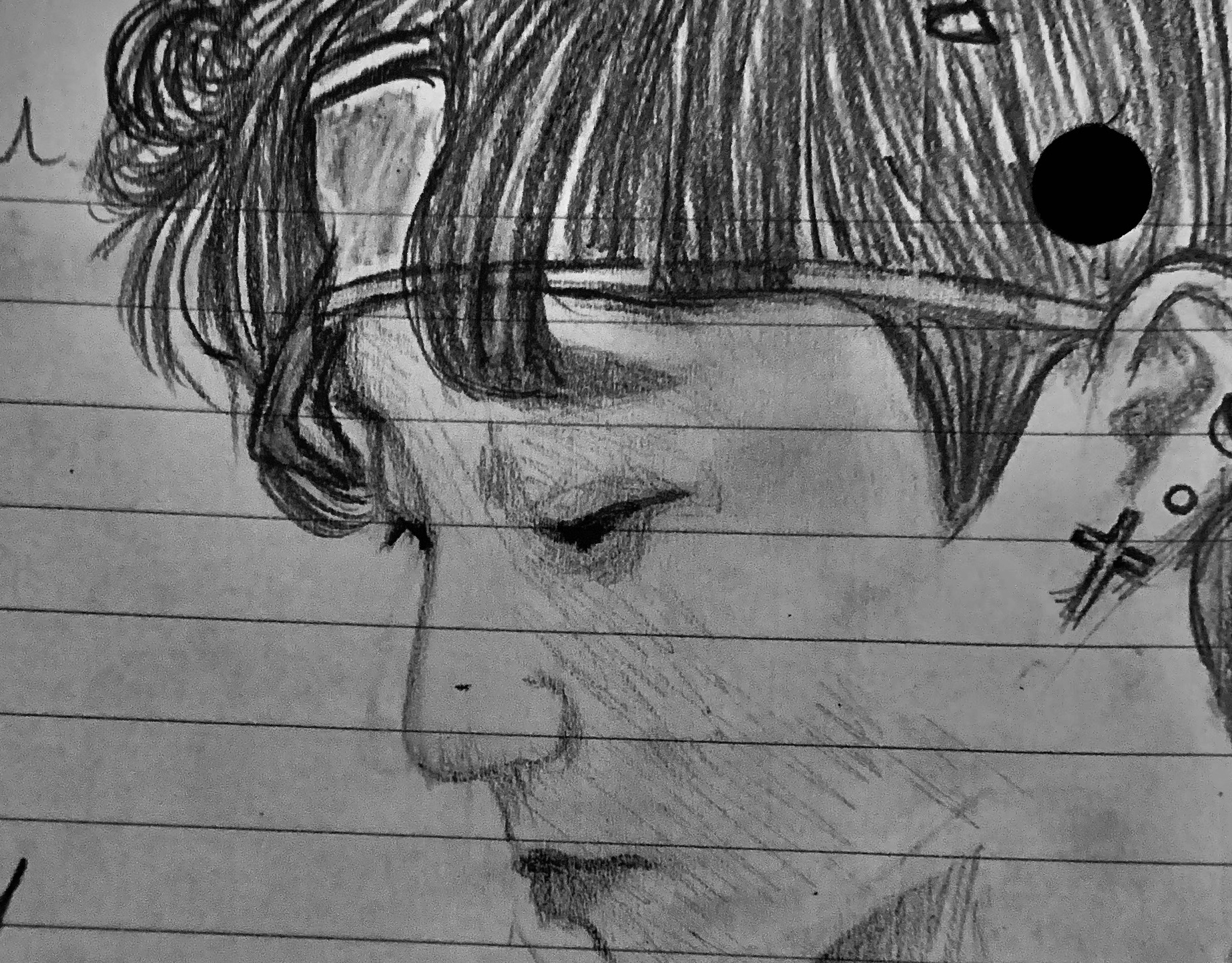
“Beomgyu” (2019)
Freehand sketch with pencil. This illustration is of Beomgyu, a Korean pop idol from the band, "TXT (Tomorrow by Together)". The aim of this piece was to practice drawing a three-fourths profile of a male subject. Focus was kept on bringing out the eyelashes, subtle lips, and hair. This was drawn in a realistic style, to test the artist's ability to capture a subject quickly.

"Crescent-Swing, Smoke-Clouds" (2016)
Drawn with ink. This sketch shows a slender hand holding a cigarette, and the illusions inside the smoke cloud. There are two eyes, fanning out like wings, and multiple crescent shapes are present. One crescent holds a ladder which pours down towards a figure, reaching out to climb it. Another crescent holds a swing, while yet another serves as a bed. A crescent ship with a figure on top sits next to an ocean. A crescent swings beneath the ship in the form of an anchor. The last hidden crescents are in the bindi/bottu of the face and in the eyes themselves to mark a line of symmetry. Finally, a face peers from behind at the cloud and the smoker. The style was meant to be surreal, dreamy, yet frazzled. The figures are inspired by Warli folk art from the Indian state of Maharashtra.
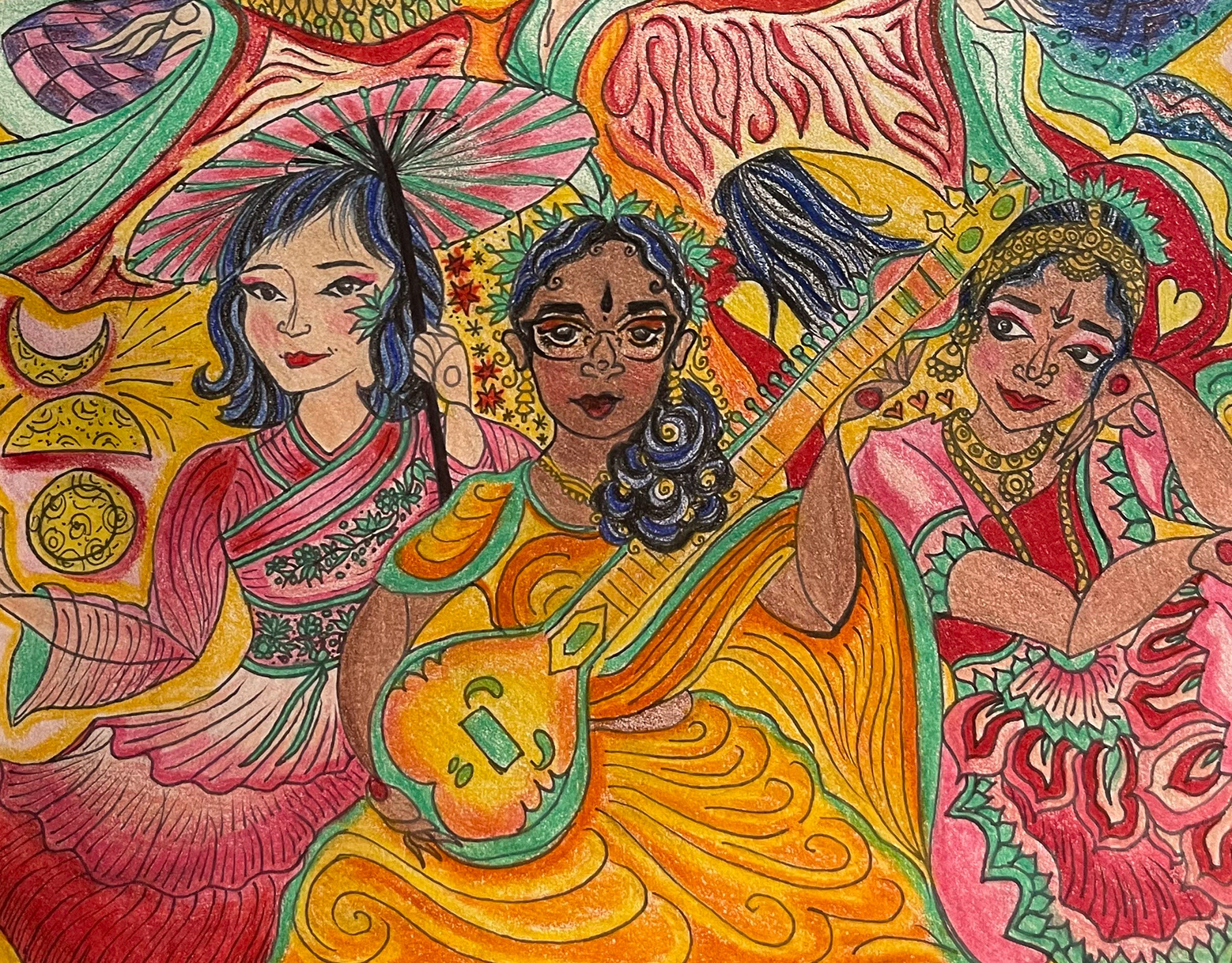
“Indo-Chinese Classical Dance" (2024)
Drawn with colored pencil and ink based on ink outline (see "Draft" in Poster section of portfolio). Each dancer is based on reference photographs of traditional Chinese classical dance costumes and traditional Indian classical dance/music costumes (Bharatanatyam, Odissi, Carnatic). Motifs associated with each culture, including a parasol and a sitar, are included. A bold, gradient color scheme which suits both cultures was applied to the clothing, hair, and backdrop. Each figure's costume, makeup, hairstyle, and accessories is distinct. Figures are arranged and layered on the poster to show people sharing classical arts and cultural spaces with each other. Motifs of the moon and the stages of love, which was the showcase theme, is included to the bottom left (moon phases) and bottom right (small hearts). Symmetry and balance was achieved by keeping figures in parallel poses and parallel colors. Finally, the cursive script used for the description stands in contrast with the showcase information, title, and the dance clubs' names (Mei-Kala). A bold, curved script was used to match the curves and angles of the performers' bodies.
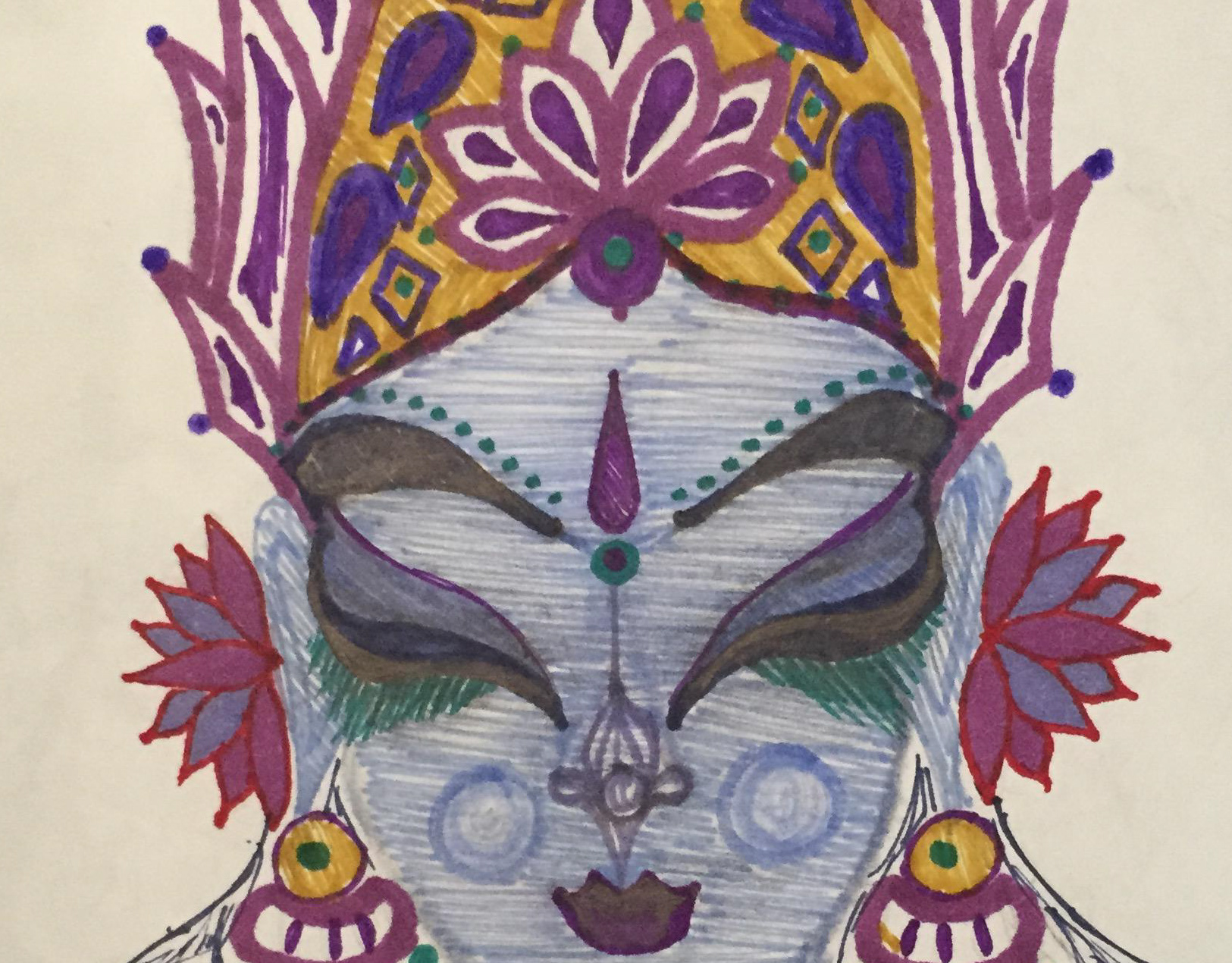
“Lakshmi: Serene Beauty” (2016)
Sketched with ink markers. Piece depicts the Hindu goddess of beauty and wealth, Lakshmi Devi. Two lotus flowers are tucked behind her ears, and her golden crown contrasts with the blue tone of her skin. Lakshmi is symbolically shown with blue skin to indicate that she is the wife of Sri Vishnu (who is also depicted with blue skin in Indian artwork to indicate that his skin is very dark, akin to that of blue rainclouds). Lakshmi's facial features in this peace are meant to bring a sense of peace, and her hair is drawn stylistically in curls.
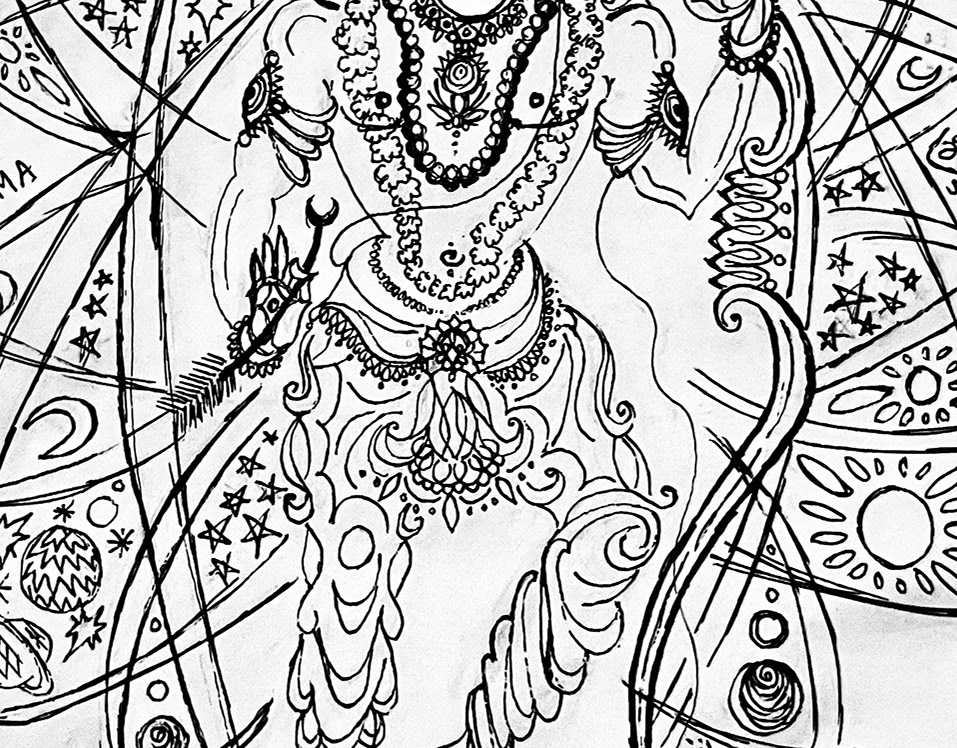
"Universe, Balance: Rama" (2023)
Created with ink, draft (scroll down) created with pencil. This illustration depeicts the Hindu god Sri Rama as the center of the universe, providing balance between opposing sides. He carries an arrow (with a crescent-shaped head, similar to that of ancient Indian arrows, which had different shapes) and bow whose string curls around his arms. His crown, belt, and jewelry indicate his status as a warrior king, and a sun-like halo surrounds his head. His forehead is covered in the symbol of the god Vishnu, whom he is the incarnation of. His pants are drawn stylistically to show draped silk. His feet have small sparks next to them. He is surrounded by a structure which contains suns and moons, planets and stars. Rama's name, in English, Telugu, and Hindi, is written amongst these parts of the universe. The structure symbolizes both the universe and an atom: to suggest that Rama is present in the largest scale and smallest scale. In this illustration, centering him within the smallest particle is a reference to Telugu poet Annamacharya's writing on the same subject. Finally, the sacred syllable "Om" outlines the structure. Note: This piece was intended to be the first in a series of illustrations for a devotional kirtan (song) about Rama, written by the late Dr. Advikolanu Muralidhar. So, this imagery reflects the lyrics. This style of art is inspired by the Vedic Art style, hence the curved body of the male figure, the oval-shaped face, and elaborate ornaments.

"Savitri" (2019)
Drawn in ink and pencil. This sketch is of the famous South Indian Telugu actress, Savitri (1934-1981) who dominated the South Indian film industry in the 50's and 60's. This illustration of her is taken from a scene in one of her film's songs, in which she stands decked in a sari, her hair adorned with a halo of jasmine flowers, a high hairbun, and a long, signature bottu/bindi on her forehead. She was easily recognizable via her distinct beauty: an oval-shaped face and wide eyes lined with kaatika (kohl). Hence, her style and features were the focus of this sketch.

"Flute Choir: Winter Concert" (2022)
Brochure designed using ink. Each piece from the concert repertoire was incorporated. For instance, "Stained Glass Windows" was a general theme, hence the entire piece is framed into a classic, Gothic window. The upper panel represents "March of the Planets," the rose beneath the planets represents the "Roses" piece, and the upper-left panel represents "La La Land: City of Stars," in which Emma Stone dances beside 5-star film ratings and a streetlight (which is reflected on the right panel's border). The upper-right panel contains Georges Bizet's "Carmen" via a sweeping skirt covered with the hearts of men who fall for Carmen. The central plum symbolizes the "Sugar Plum Fairy," the reed flutes lining the lower left and right panels' edges are from the "Dance of the Reed-Flutes," all from Tchaikovsky's "Nutcracker Suite." "March" from "Nutcracker" is combined with the "March of the Toys" piece in a soldier-teddy-bear playing piccolo on the lower right panel. "I Have a Dream" from "Les Misérables" is captured on the lower left panel through the girl from the novel's book cover. Finally, "Treasures Under the Sea" is portrayed through treasure chests and seaweed in the lowermost panel. Bold lines and reflective scripts are used to highlight the concert date as window shutters. The "Bi-Co" or bi-college is similarly kept in thick, sharp angles, with "Winter Concert" script kept in diminishing/growing font. The entire brochure design exemplifies symmetry and harmonious composition.